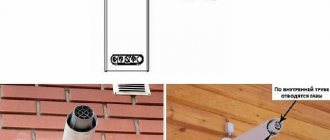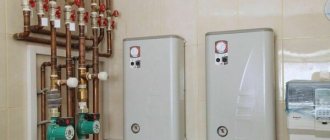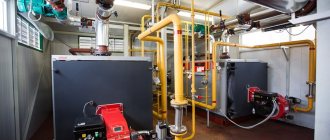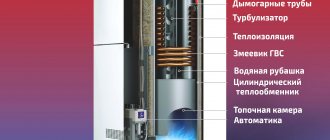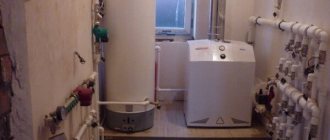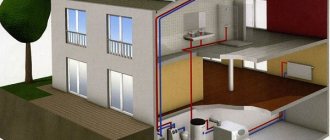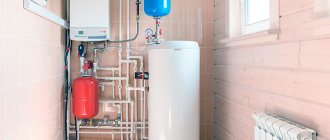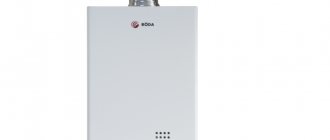Home / Solid fuel boilers
Back
Published: 02/27/2020
Reading time: 5 min
0
6536
Installation of a blower fan on a solid fuel boiler is carried out to optimize combustion processes, which leads to an increase in the efficiency of the thermal circuit and fuel economy.
A fan for a solid fuel boiler can be made independently, which will allow the owner to save significant funds on purchasing a factory-made analogue.
- 1 Purpose of a fan for a boiler
- 2 Design and principle of operation
- 3 Varieties 3.1 Electrically commutated motor
- 3.2 Synchronous motor
- 3.3 Blowers with asynchronous motor
How does a turbocharged gas boiler work?
In turbocharged boilers, the influx of combustion air and at the same time the outflow occurs through a coaxial chimney
. A turbocharged gas boiler is a unit that has in its design:
- channel for air inflow and exhaust of combustion products;
- electric turbine;
- closed combustion chamber;
- one or more heat exchanger;
- multi-nozzle burner;
- pump for forced pumping of coolant;
- gas module;
- electronic control system for the operation of the installation.
Depending on the power of the unit, heat exchangers and a burner of appropriate size are installed on it. The larger they are, the larger the overall dimensions of the installation.
The product body itself, in which the listed elements are installed, is made of sheet metal. It has special mounting holes that allow you to fix the device on a vertical wall surface.
The best known manufacturers and models: characteristics and prices
ATOS + WPA 120
One of the best and most common automation kits for solid fuel heating boilers.
The ATOS controller is distinguished by extremely wide functionality, a considerable number of customizable operating parameters and an affordable price. In addition to standard functions, there is: protection against freezing of the heating system; notification of temperature drop or overheating, lack of fuel; LED indicators of circulation pump and fan operation; adjustable hysteresis. It is also known for its reliability due to operational practice. Manufacturer: KOM-STER, Poland.
Blower fan M+M WPA 120 is also the most common, time-tested Polish model. Designed to work with boilers with a power of 25-50 kW. There are other versions on the market for more or less powerful boilers.
Cost of the set: 8,900-10,000 rubles.
Boilers with a burning duration of one load of fuel up to 7 days
COMFORT-ECO + NWS-100
The controller is another Polish model: with almost the same functionality and reliability for an even more modest price. Functionality implies the presence of all safety functions, the ability to connect a room thermostat and outdoor sensors, control of a circulation pump (but not DHW). It features a fail-safe filter and an overload fuse.
The Nowosolar NWS-100 turbine is a simple Polish aluminum model, one of the most inexpensive on the market. It has an unremarkable standard design, known for high-quality assembly and reliability. The model is designed for installation in boilers with a power of 30-50 kW.
Cost of the set: 8,500-9,800 rubles.
Tech ST24 + WPA 120
The controller is a hassle-free, simpler model, equipped only with standard functions: control of the boost fan speed, control of the circulation pump, LED indication of the operation of the elements. Installation of external sensors and automatic feeding systems is also not provided. An excellent choice, but at a price comparable to more functional models. The fan is the most common model already described above.
Cost of the set: 9,200-10,500 rubles.
KG Elektronik CS-18S + DP-120
The Polish controller KG Elektronik CS-18S is one of the most modern and functional on the market. It is distinguished by the presence of a touch screen control, the ability to control the fan, circulation pump, hot water supply, and automatic supply system. The DHW pump can be made a priority; there are also special modes adapted for each type of fuel: wood, wood and coal, coal, sawdust. All existing protective mechanisms are also provided: against overheating and freezing, stopping the circulation pump.
The KG Elektronik CS-18S + DP-120 fan is also one of the best. It features an asynchronous motor and high performance with a relatively low noise level of up to 63-65 dB. It has a metal damper at the outlet that blocks the reverse flow of exhaust gases.
Cost of the set: 11,000-12,500 rubles.
Operating principle of the equipment
The difference between an atmospheric and a turbocharged gas boiler is the presence of a fan.
A turbocharged boiler works as follows:
- After power is supplied to the installation and it is turned on in operating mode, the turbine fan starts.
- For a few seconds, the sensor in the pipe determines the strength of the air flow and, if everything is in order, gives the command to start the piezoelectric ignition.
- After a few seconds have elapsed after a stable spark appears, the valve in the methane supply module opens, allowing the latter to enter the burner.
- A flame appears, which begins to heat the heat exchangers with water.
- Upon reaching the set temperature in the system, the temperature sensor is triggered and gives a command to close the valve in the gas module.
This process continues in a circle in automatic mode; the operator can only adjust the required temperature of the coolant.
Blower for the boiler: why install a blower
Installing a blower for the boiler is necessary to create forced draft. Thanks to this installation, the required amount of air will be supplied into the chamber continuously.
Thanks to the boiler vent, you can speed up the combustion process
Why else do you need a blower:
- If there is not enough air, the full operation of the boiler may be disrupted. The fuel will no longer burn completely, and the chimney will become clogged more often. This will lead to additional cleaning costs.
- If the fuel does not burn completely, the insulating materials will begin to burn out, and their regular replacement or repair will lead to an increased cost of operation.
- Due to the decrease in draft, the room will begin to become saturated with smoke. This will result in the owner needing to install additional ventilation.
It is for these reasons that it is better to initially purchase a blower, spending a certain amount on it once, and you can do the installation yourself.
Performance indicators
The most important performance indicators of gas turbo boilers are:
- product reliability;
- durability;
- unit survivability.
The most vulnerable design elements of any heater are the heat exchangers and burner, which are subject to constant heating. The former can burn out, while the latter's nozzles periodically become clogged during operation. The faster and easier these faults are eliminated, the higher the performance of the model.
DIY making
The thermostat, as an automatic device for regulating the operation of the heating system, can be purchased at the electrical goods retail chain. At the back of this device there is a heat removal plate; it will need to be pressed against the exposed part of the unit.
The thermostat has three contacts inside: common, normally open and normally closed. By rotating the adjusting knob, you can change the positions of the contacts.
So you need to set the handle to the minimum mark and connect to the open contacts:
- to the general one .
- We connect one wire from the turbine to the open one
- to the second wire from the turbine .
An automated control system is rightfully considered not only convenient, but also an effective device. With its help, you can significantly simplify the process of operating the heating system.
Solid fuel, such as firewood, has been considered excellent since ancient times.
A wood-burning boiler is perfect for country houses to heat your home. Of course, with the pace at which technology is developing, you can see that firewood has given way to other fuels. But even at the moment, wood-burning boilers continue to fully perform their duties and help out those who do not have the opportunity to connect to gas equipment or use home electricity.
Types of smoke exhaust ducts and features of their design
Types of chimneys that a gas boiler can be connected to.
Engineers of methane-fired boiler equipment have developed several types of chimneys that can be connected to:
- vertical type;
- horizontal type;
- two-channel vertical design.
You can also always use an ordinary brick pipe as a chimney, having previously modified its design in accordance with the operating standards of boiler equipment.
Vertical chimney
A pipe with one channel is the simplest design. It can be made of stainless steel or galvanized steel. Such a chimney is assembled from separate sections of a thin-walled structure or with several walls, between which there is a layer of insulation. As a rule, this pipe system has a settling tank for settling soot or condensate. The heat generating equipment is connected to the channel from the side, just above the bottom end.
Horizontal smoke exhaust channel
A horizontal type chimney can be single-channel or two-channel, called coaxial. The latter option is often used for turbine boilers where the air supply is from outside the building. The coaxial system can be made of stainless steel, galvanized and special plastic. The most reliable option is a stainless steel chimney, as it has increased resistance to the acidic environment resulting from the combustion process.
The internal duct of the two-channel system is exhaust, the external one serves for air flow into the chamber.
Two-channel vertical system
You can use a brick stove pipe for the boiler.
A vertical pipe with two channels is most often used in multi-storey buildings with a centralized chimney system. Several units can be connected to such a pipe at the same time. A chimney exhaust project of this type takes place in houses where it is not desirable to weaken the supporting structure by drilling holes in the wall or in order to preserve the decorative facade of the building.
Connecting the boiler to a conventional chimney
In old houses with stove heating, you can use the existing brick pipe as a chimney for a heat-generating unit. The disadvantage of this option is that the smoke, consisting of steam and carbon dioxide, does not have a high temperature, condensation will constantly form on the pipe, it will begin to freeze and quickly collapse. Therefore, such structures need to be additionally insulated.
Causes of poor traction
The draft worsens when there is strong wind outside.
A difficult situation arises if the chimney is designed and laid incorrectly. An inexperienced person selects the wrong pipe diameter or makes a mistake with the length. The smoke removal system must be rebuilt to provide traction force.
There is no traction if the tightness of pipe connections, elbows, or bends is broken. You can increase smoke extraction by sealing all the holes through which hot air leaks. Clogging of the outlet channel with soot also causes a decrease in draft or reverse movement of combustion products. Sometimes heat exchangers of various designs are installed in the smoke exhaust duct to collect heat and reuse it. But built-in installations affect traction and worsen fuel combustion.
Traction force weakens under conditions:
- rain, fog;
- high air humidity;
- high temperature outside;
- high wind speed.
Backdraft or overturning occurs when there is no vacuum in the chimney. Combustion products are not removed from the room into the atmosphere and are drawn into the boiler room, which is dangerous for humans from carbon dioxide poisoning.
Pros and cons of turbocharged gas boilers
The fan of a turbocharged boiler cannot operate without electricity.
Boiler equipment with a built-in turbine has the following advantages:
- high efficiency, reaching 95%;
- does not require the construction of a complex vertical chimney like an atmospheric one;
- has an increased level of safety, eliminating the possibility of methane and carbon monoxide getting inside the room;
- compact and does not require a separate boiler room for installation, like an atmospheric apparatus;
- equipped with an automatic control system with the ability to operate from external temperature sensors.
The disadvantages of installations include:
- the energy dependence of the unit, which cannot function in the absence of mains voltage;
- high cost of both the equipment itself and components if repairs are necessary.
The choice of an atmospheric or turbocharged boiler depends on the technical capabilities of the structure.
Varieties
Today, in the retail chain, it is possible to purchase various models of blower fans for solid fuel heating units, both domestic and European assembled.
The most popular options for the location of blowing units are:
- The invoice is installed on a vertical section of an uninsulated smoke ventilation duct.
- Centrifugal duct, have two mounting pipes installed in the chimney gap.
- Boiler installed directly on the heating device.
The following classification of blowing units is made according to the type of electric motors: asynchronous, electrically commutated EC and synchronous.
Electrically commutated motor
The Electronically Commutated Motor (EC) allows very precise performance adjustments using a pulse width modulation signal.
Electrically commutated drive
In the case when they are installed on blowing devices, it becomes possible, by changing the speed of rotation of the impeller - impeller, to change the volume of air supplied to the furnace, thereby reducing energy consumption from 50 to 80%.
Despite the high cost of such blowing devices, they are preferable in the installations of modern boiler units, since they are energy-efficient devices, and their use reduces emissions into the environment by reducing thermal energy losses due to underburning of fuel.
EC motors operate in a quiet range and have an extended service life.
Synchronous motor
The blower fan for a boiler with a synchronous motor is characterized by a simple design and a low price. The disadvantages of this model include a limited adjustment range and low torque when starting the engine. As a rule, such blowing devices are installed to supply a constant volume of air into the combustion chamber.
Boilers with fairly large dimensions are equipped with such engines. Basically, such engines are mounted in a separate block.
When operating synchronous motors at low speeds, winding overheating often occurs. In an exhaust type boiler, fans are installed on the chimney; they are also called smoke exhausters.
Blowers with asynchronous motor
Such electric motors have many advantages. They are convenient and easy to maintain and are durable in design. A disadvantage of this type of electric drive is high starting currents.
Therefore, it will be necessary to properly arrange the power part in order to put into operation such a device that is sensitive to current parameters.
The asynchronous electric motor makes it possible to easily adjust the speed. Certain modifications also have a reverse mode. The main positive qualities of fans with an asynchronous electric motor:
- simple and easy to use;
- have a durable design;
- traditional control scheme;
- used by a variety of control systems paired with a thermostat, for example, like the budget fan DP-02 from a Polish manufacturer.
What to look for when choosing a device
Turbocharged and atmospheric boilers are selected according to power.
When choosing methane boiler equipment, they are primarily determined by the thermal power that will be sufficient to heat a particular building. The standard ceiling height of up to 3 meters with average insulation of the external wall assumes the consumption of thermal energy per 10 square meters within 1 kW. You also need to consider:
- A single-circuit boiler is designed for heating only. To have hot water in the tap, you need a double-circuit one.
- Devices with copper heat exchangers have proven themselves well - they are durable and heat up quickly.
- For running models it will always be possible to find components and a service center for maintenance.
Modern devices allow you to control them through special applications on your smartphone.
